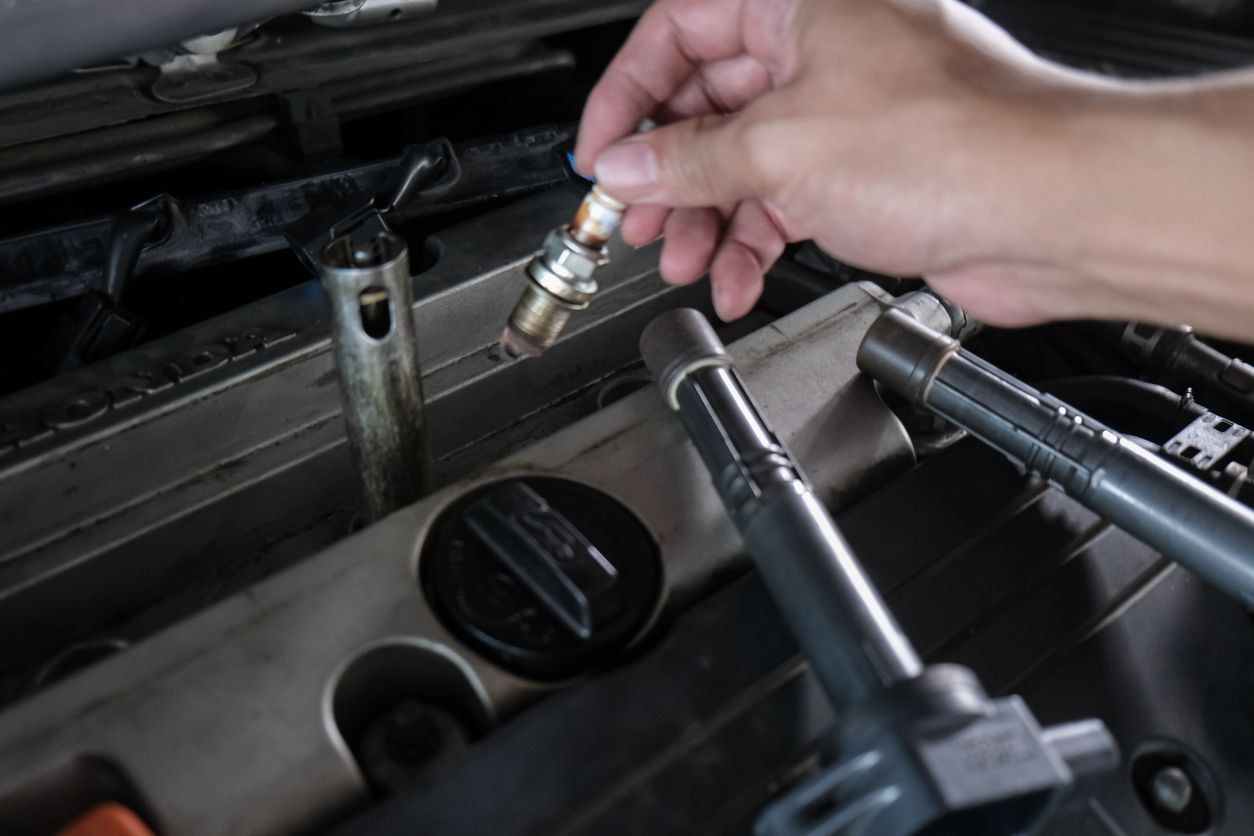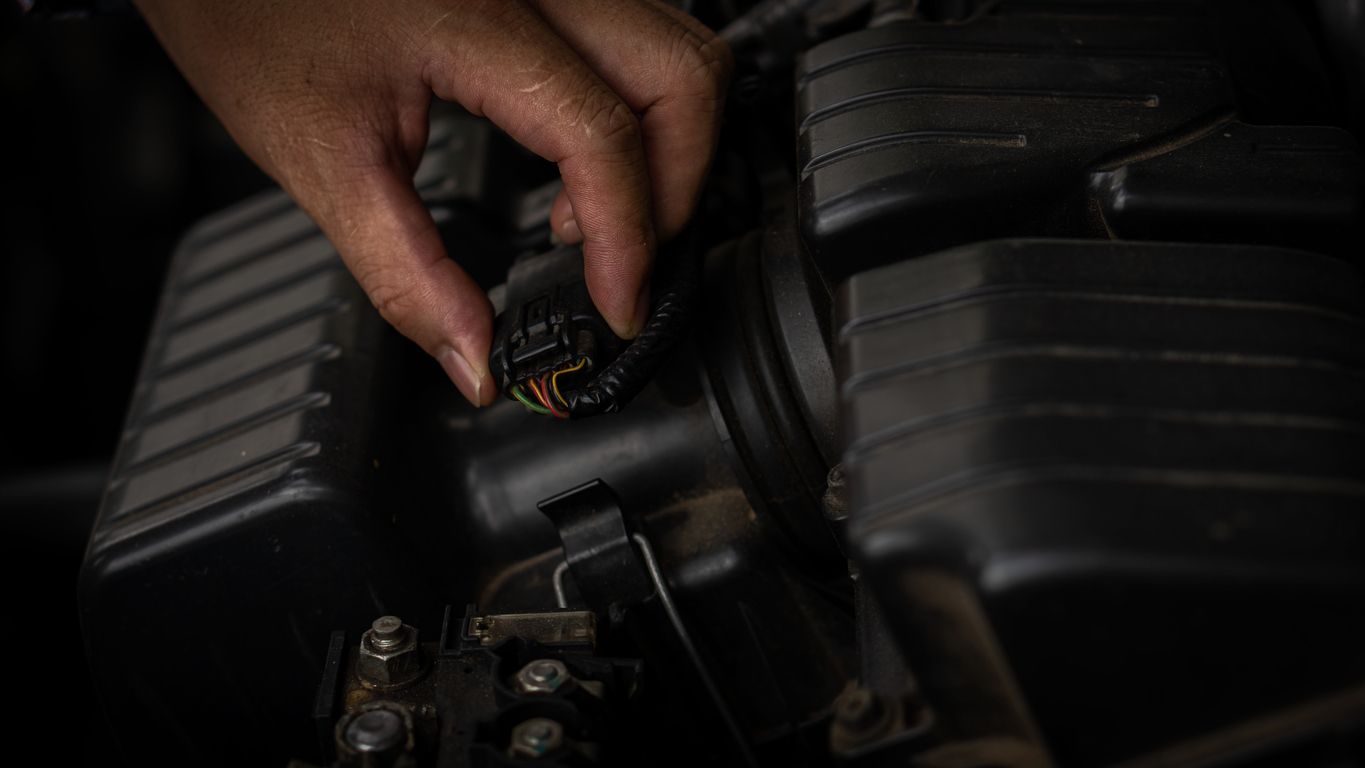Ignition coils help create the spark that fires up your engine. Without them, you’ll quickly find your car sputtering to a halt or not starting at all. Since they’re directly linked to the performance of your spark plugs and engine, ignition coil failure symptoms will be hard to ignore—and should be repaired promptly!
Keep reading to learn the telltale signs of a faulty ignition coil, what causes ignition coils to go bad, and get the answers to frequently asked questions like how to check an ignition coil under your hood.
What Are Ignition Coils?
An engine needs four things to run: air, fuel, compression, and a spark. While that spark comes from your vehicle’s spark plugs, it’s the ignition coils that power each plug, converting your car’s 12-volt battery power into as much as 40,000 volts in larger engines. That sudden spike in voltage ignites the air-fuel mixture in your engine, powering your drive.
Most modern vehicles use a coil-on-plug system, where each spark plug has its own ignition coil. Your car’s computer controls when each coil fires, based on input from various sensors. Typically, you’ll have one ignition coil per engine cylinder—so four coils in a four-cylinder engine, six in a six-cylinder, and so on.
What Are the Symptoms of a Failing Ignition Coil?
A failing ignition coil can severely damage your engine. Before things get that far, keep an eye out for these potential ignition coil failure symptoms:
1. Check Engine Light is On
One of the most obvious signs of a faulty ignition coil, is an illuminated check engine light. Your car’s computer constantly monitors the ignition system, and if a coil isn’t sending enough voltage to a spark plug, the system will flag it.
At that point, leave it to the pros at Firestone Complete Auto Care to diagnose the check engine light with an OBD-II scanner and get you the ignition coil replacement you need.
2. Difficulty Starting Your Engine
Since ignition coils are responsible for delivering electricity to your spark plugs, it may be difficult to start your engine if a coil fails. In fact, if you have an older vehicle with a single ignition coil, your vehicle may not start at all. In coil-on-plug systems, however, you might experience the jerky or sputtery starts of a “dead” cylinder during startup instead of a full no-start as your engine’s remaining cylinders try to compensate for the loss of power caused by the bad coil.
3. Engine Misfiring
That “dead” cylinder feeling is known as misfiring, and may also occur while driving. A misfiring engine will typically run poorly, shake, and vibrate while idling—and jerk or sputter while moving. A bad misfire may even cause your check engine light to flash, indicating a severe issue that needs to be addressed immediately. Misfiring puts incredible strain on engine components, so we recommend bringing your car in as soon as possible if you notice any of these symptoms.
4. Engine Backfiring
If you’re hearing a loud banging or popping sound coming from your vehicle’s exhaust, it could be a faulty ignition coil causing your engine to backfire. As your engine attempts to burn more fuel to make up for the bad coil’s cylinder, some of that fuel may leave the engine prematurely and enter the exhaust system. Backfiring happens when that unburned fuel detonates in your exhaust, potentially damaging critical exhaust system components.
5. Vehicle Stalling
An engine that suddenly dies while idling or driving may have one or more coils intermittently cutting out. This is more common in older ignition systems or coils exposed to high heat.
6. Less Power and Lower Fuel Economy
When spark plugs don’t receive enough electricity from their ignition coil, they may fail to spark or only do so intermittently, resulting in reduced power output from your engine. Your engine tries to make up for this lack of power by consuming more fuel, which reduces gas mileage and can foul spark plugs (which can catalytic converter damage as well). Put it all together and you get one highly unpleasant driving experience full of stalling, slow acceleration, and rough idling—all thanks to a simple ignition coil failure.
Bad coils may not be the only thing hurting your fuel economy. Get your coils checked out and make sure your whole car is operating at its best to give you the best gas mileage with a complete vehicle inspection at Firestone Complete Auto Care.
What Causes Ignition Coil Failure?
Like any part, ignition coils are subject to wear and tear over time. For many vehicles, it's a good idea to consider ignition coil replacement around every 80,000-100,000 miles or so. However, other circumstances may lead to premature ignition coil failure, like:
Poor Air-Fuel Mixture Ratio
If the air-fuel mixture isn’t at the correct ratio, your engine is likely to run too lean (too much air) or too rich (too much fuel). When either happens, your ignition coils are forced to work overtime to deliver power to the spark plugs.
- Lean mixtures require higher voltage to ignite, which can overwork and overheat ignition coils.
- Rich mixtures leave behind carbon buildup, which can foul spark plugs and interfere with the coil’s ability to send power effectively.
Spark Plug Gap Too Big
For spark plugs to operate properly, the space between their electrodes must be gapped correctly. Spark plug gaps naturally widen over time, so it’s important to monitor their health.
Too small of a gap, and the spark generated may be too weak to efficiently combust fuel. Too large of a gap, and the spark may not jump the gap consistently. To bridge a larger gap, ignition coils must deliver more voltage than otherwise necessary, leading to faster wear out.
Valve Cover Leaks
While today’s coil-on-plug setups deliver stronger and more accurate sparks than single coil systems of the past, their position under the hood makes them more susceptible to moisture—and it’s no secret that electronics and moisture don’t mix well.
In many COP systems, the coil sits directly above its spark plug, which resides inside a tube in the engine's valve cover. Over time, the rubber between the spark plug tube and the valve cover may break down and let oil inside of that tube, shorting the spark from ignition coils and fouling spark plugs in the process.
Excessive Engine Heat
High temperatures under the hood can cause ignition coils to overheat and degrade faster. Excessive engine heat can stem from various issues, including cooling system problems like low coolant, a stuck thermostat, or a clogged radiator.
Electrical Overload or Faulty Wiring
Bad wiring or poor grounds can damage ignition coils. Even a weak battery or malfunctioning alternator can affect coil performance by delivering inconsistent power.
How To Prevent Ignition Coil Failure (Potentially)
Ignition coils are built to last, but like many components under the hood, they can wear out over time—especially when exposed to heat, moisture, or engine misfires. Here are some straightforward tips to potentially help extend their life and avoid unexpected breakdowns:
- Replace Spark Plugs on Schedule: Incorrectly gapped or worn spark plugs force ignition coils to work harder, increasing the risk of failure. Replacing spark plugs at the recommended intervals reduces unnecessary strain on the coils.
- Address Fluid Leaks Promptly: Oil or coolant leaks can seep into ignition coil connectors, causing shorts and corrosion. If you notice any leaks around your engine, have them inspected and repaired promptly to prevent electrical issues.
- Respond to Check Engine Lights Quickly: A flashing or solid check engine light could indicate a misfire or ignition problem. Early diagnosis and repair can protect your coils and your engine from damage caused by unburned fuel or overheating.
- Use Quality Replacement Parts: Opt for trusted brands when replacing spark plugs or ignition coils. Low-quality components may not perform properly and can lead to early failure.
- Schedule Routine Inspections: During regular maintenance, ask your technician to inspect your ignition system. A quick check can uncover signs of wear before they turn into costly repairs.
Bad Ignition Coils FAQs
Can You Drive with a Bad Ignition Coil?
For coil-on-plug ignition systems with multiple ignition coils, it may be possible to drive with a bad coil—but we don’t recommend it. Driving with a faulty ignition coil can lead to engine misfiring, poor fuel efficiency, damage to engine and exhaust components, and a really rough ride.
How Long Can You Drive with a Bad Ignition Coil?
The short answer? Just long enough to get to your nearest Firestone Complete Auto Care for an ignition coil replacement.
In reality, there’s no set time limit to how long your engine will hold out—although, the longer you continue to drive with a bad ignition coil, the worse the damage will become.
How Long Do Ignition Coils Last?
Ignition coils typically last upwards of 100,000 miles. Actual mileage will vary based on your vehicle and driving habits, but regular maintenance of ignition system components can help maximize the life of your coils.
How Can You Prevent Ignition Coil Failure?
There’s no secret to preventing ignition coils from failing. The best course of action is simply to keep up with regular maintenance of your ignition system to minimize wear and tear on your coils.
That means using high-quality OEM replacement parts for coils and spark plugs, ensuring spark plugs are clean and properly gapped, maintaining a healthy air-fuel mixture in your engine, and watching out for valve cover leaks and moisture.
How Do You Check an Ignition Coil?
Checking the condition of your ignition coils is best left to a professional. Faulty ignition coils and spark plugs result in many of the same symptoms, and, depending on your vehicle model, accessing the rear coils may require removing the intake manifold.
Furthermore, accurately testing a coil’s voltage requires special tools like an oscilloscope and the knowledge to handle high-voltage equipment safely.
How Do You Fix a Bad Ignition Coil?
Fixing a bad ignition coil involves diagnosing the specific coil that has failed, removing it safely, and installing a replacement correctly. While a quick scan of your car’s computer can usually tell you which coil is faulty, it’s best to leave its replacement to the experienced technicians at Firestone Complete Auto Care to ensure proper installation.
Should I Replace All of My Ignition Coils at Once?
Generally speaking, you only need to replace the faulty ignition coil to get your engine running smoothly again. However, if all your coils are around the same age or are close to 100,000 miles, it may be smart to replace them all together to avoid another trip to the repair shop when the next ignition coil fails.
Keep Your Coils Firing on All Cylinders at Firestone Complete Auto Care
A faulty ignition coil can lead to serious engine damage and discomfort on the road—from stalling and backfiring to engine misfiring. Ensure a safe and smooth transit for you and your passengers when you stop by your local Firestone Complete Auto Care for inspections and Engine Care Services. Schedule an appointment today!



